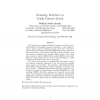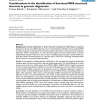146 search results - page 17 / 30 » Segment-Based Scores for Pairwise and Multiple Sequence Alig... |
JCB
1998
13 years 7 months ago
1998
The function of an unknown biological sequence can often be accurately inferred by identifying sequences homologous to the original sequence. Given a query set of known homologs, ...
BMCBI
2011
13 years 2 months ago
2011
Background: It is difficult to accurately interpret chromosomal correspondences such as true orthology and paralogy due to significant divergence of genomes from a common ancestor...
RECOMB
2012
Springer
11 years 10 months ago
2012
Springer
We develop a novel and general approach to estimating the accuracy of protein multiple sequence alignments without knowledge of a reference alignment, and use our approach to addre...
BMCBI
2008
13 years 7 months ago
2008
Background: A multiple sequence alignment (MSA) generated for a protein can be used to characterise residues by means of a statistical analysis of single columns. In addition to t...
BMCBI
2007
13 years 7 months ago
2007
Background: Accurate identification of novel, functional noncoding (nc) RNA features in genome sequence has proven more difficult than for exons. Current algorithms identify and s...


